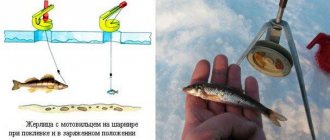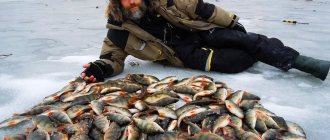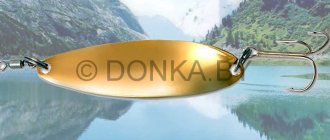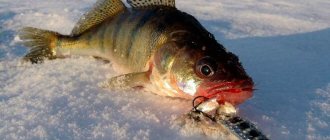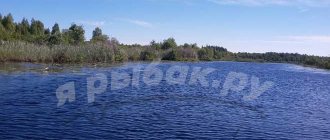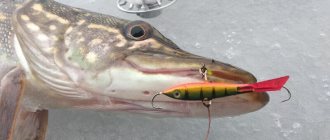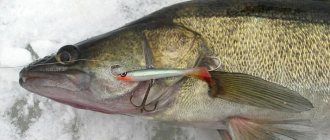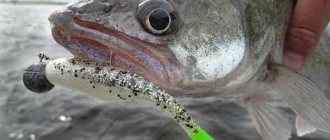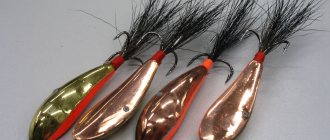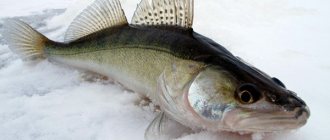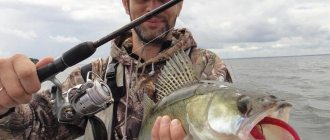To successfully catch pike perch in winter using sprat, it is not enough to just have bait; here, pay special attention to the choice of a promising place, gear, and also know how to choose this favorite food of the predator. Ice fishing for pike perch in winter is interesting for both professionals and beginners. This fish is distinguished by increased caution and cunning; it is a pleasure to fight such a worthy opponent. On average, the weight of prey is 4–5 kg, which is pleasant for every predator hunter. Catching pike perch using sprat in winter is not difficult, the main thing is to prepare thoroughly.
How to choose and where to get sprat for fishing
Fishing with sprat in winter is especially common in the Volga reservoirs. There, local fishermen catch it using a spider near hydraulic structures. This is the main food for pike perch; bait in the form of small fish is always relevant. The predator rushes at her almost immediately as soon as she comes into his field of vision. The attractive factor here is both the smell and the silvery scales of the sprat.
To attract a predator to the sprat in winter, it is necessary to use fresh bait for each recast of the tackle. Small fish are not able to withstand sudden changes in temperature, losing their attractiveness to predators.
It is not recommended to freeze the sprat several times; it will lose its elasticity and fly off the hook. Using fresh fish increases the chances of catching even the most cautious predator.
Stocking up on sprat for ice fishing is quite problematic. In winter, it bites mainly in the dark, and frosts during this period are much stronger than during the day. Therefore, you need to be prepared for such severe tests. It is better to go out to the pond for small fish in the worst weather, when a strong wind is blowing and the temperature has dropped very low. In such conditions, the sprat exhibits stable activity, and bites are quite frequent.

The best option for catching bait for pike perch is the little one. They catch with this simple trap until the reservoir is covered with ice. The caught prey is packaged at home in bags, up to 25 pieces in one, and placed in the freezer. The most catchy baits are considered to be 4–5 cm long.
You can buy sprat in the store, preferably fresh, and at home put it in bags and freeze it. The bait is defrosted directly on the pond, the minimum number of fish is 50 pieces. Often, during active biting, 150–200 fish are consumed. Freezing the remaining sprat a second time is pointless, it will be soft and unpresentable, and a predator in the water won’t even notice it.
Advantages of catching pike perch with sprat in winter:
- availability;
- catchability;
- versatility of use;
- attractive appearance;
- ease of fishing;
- pleasant aroma;
- plausibility of the predator's main food;
- excellent irritant.
You can catch pike perch using sprat in winter not only on the first and last ice, but also during the deep winter. This small silver fish works where other baits are powerless, even spinners for zander in winter and balancers. Pike perch and other representatives of the predatory category of fish also bite on it.
Useful tips and common mistakes
It’s good to take the advice of experienced fishermen and avoid mistakes for effective fishing.
Errors:
- Using a fishing line that is too thick. In this case, sensitivity disappears. You can't count on contact with the bait.
- Tying a carabiner at the end of the fishing line. Statistics show that during a sluggish bite, the predator sees only this detail.
- Twister too hard. Especially if the fish behaves passively, it is better to take a soft twister made by a well-known manufacturer.
- Large bait. Sufficient length of the fish is 4 cm.
- Do not change the fishing spot. Many anglers believe that fish need to be hatched. It is not right. If there is no bite, you should not stay in place for longer than 15 minutes.
- Fishing away from the shore. The bulk of the good catch is made closer to the shore. Removal by boat can be done no more than 2 meters.
Helpful Tips:
- To find a suitable place, it is advisable to use an echo sounder. Measuring the depth of the reservoir and determining the bottom topography will significantly save time and increase the opportunity to catch a lot of fish;
- For successful fishing you will need a sharp hook. You can catch a large predator using a sprat. The hook will help you easily pull the catch out of the hole;
- It is better to take an ice screw with a diameter of at least 12 cm;
- Winter fishing for pike perch is an active process. You may have to drill several holes while moving across the ice. Therefore, you will need suitable clothing that can keep out the cold and wick away excess moisture.
To catch pike perch in the winter month, you should remember about the correct choice of fishing location and equipment. When fishing, don’t forget that the predator loves to play with the bait.
Let's celebrate! He will be attracted by the bright aroma of sprat and its natural appearance. Once the bite is successful, it is better not to hesitate - the prey is strong and can fall off the hook of an indecisive fisherman.
Where to look for a predator in winter
Catching large pike perch from ice on sprat involves dynamic movement across a body of water; you will need to cover a considerable route in search of working points.
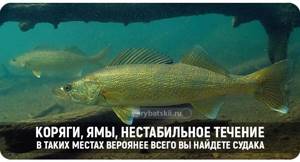
The following areas of the reservoir often turn out to be promising:
- snowy terrain;
- pits;
- eyebrows;
- depth changes;
- places with variable currents;
- hills;
- shallow water (at the beginning and end of the cold season);
- rubble of stones.
When hunting a fanged predator, keep in mind that the lower the temperature, the deeper it is worth checking the horizons. During the first ice, pike perch is often found in shallow water; it leads an active lifestyle. During the last ice, when the pre-spawning feast approaches, a rather strong appetite awakens. Its prey is a flock of fry that live at shallow depths near areas where melt water flows, stream beds, and rivers. For pike perch, it is preferable to be in a reservoir with a rocky bottom, where there is no silt, mules, and the water is quite clean.
You can easily catch a fanged predator at night, when it rises to the upper horizons in search of food. Here, in order not to waste time and quickly find mining areas, it is worth using an echo sounder. First of all, you need to fish edges, recesses and depth differences. In most cases, the coveted trophy is found in places where the height of the step at the bottom is about 1 m. Places with fast currents are also promising.
Pike perch shows an increased interest in natural bait when the temperature varies between -2...-12 degrees. It is optimal to go hunting either early in the morning or late in the evening.
Fishing technique
The main guarantee of a good catch is knowledge of the reservoir where you plan to catch pike perch.
Taking into account the available information, it is necessary to apply the following tactics:
- The most promising places where you can find a predator are areas with rapid currents near snags, as well as deep slopes: they need to be checked first.
- In most cases, pike perch prefers to stay not far from the bottom of the reservoir, so it is necessary to set the working depth to 15-25 cm from its surface if fishing is carried out in reservoirs with rapid currents. In cases where the current is too slow or completely absent, this figure should be increased to 50 cm.
- When a pike perch is found at a certain depth, it is necessary to record it and, if it moves to other parts of the reservoir, try to catch the pike perch, taking into account the already known approximate location.
Bait game
The game that the bait should show depends primarily on the fishing conditions. The basic rules to follow are given below:
- When fishing on rivers with rapid currents, no additional actions are required from the angler; moving streams of water will do all the main work for him.
- Swings of the spinner should not be too fast, and the amplitude should be maintained at no more than 25 cm, which will ensure optimal play.
- When using fairly heavy jigs with a sprat-type attachment, it is not necessary to demonstrate any kind of game; passive fishing will be no less effective.
- In reservoirs with weak currents, it is recommended to use summer oscillating spoons; when making movements, the bait should always return to its original depth, the range of fluctuations relative to the distance from the bottom surface is 25-50 cm.
How to properly place a sprat on a hook
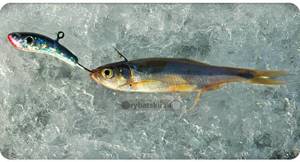
To ensure that the bait does not fly off and has an attractive appearance, you need to place it on the hook correctly. You can use one of the following methods:
- From below by the jaw. It is enough to carefully pass the hook tip through the nostril, and the small fish will remain in a mobile state for a long time. The disadvantage here is that the predator often descends; he can easily remove the bait from the hook.
- Through the mouth. This method involves extending the sting through the dorsal fin. It is more relevant when using small-sized baits.
- Through the tail. This option is especially popular among winter anglers; the bait “sits” quite securely on the hook. Thanks to the enticing vibrations that it creates during the fishing process, the predator notices it even from long distances. This method is also used when hunting in the current.
Read about other popular options for attaching live bait to a baitfish hook.
How to catch pike perch using sprat
When preparing gear, you should take into account that you will have to fight with a fairly strong and weighty opponent. If the equipment is not of high quality, then the probability of damaging the equipment is very high.
Rod accessories
To be guaranteed to catch a large pike perch, you need to choose a strong and fairly rigid fishing rod for winter fishing with sprat.

A winter fishing rod for pike perch must withstand serious loads. Soft models will not withstand the struggle of an aggressive predator when he is hooked and feels danger. In addition, fish migrations will be provoked by the inability of the hook to penetrate the hard jaw of the fanged predator. When choosing a suitable fishing rod, it is very important to pay attention to the presence of sufficient shock absorption; if it is not there, then it is unlikely that you will be able to make a confident hook.
For pike perch you need to use the strongest and sharpest hooks possible. The reel here is suitable from the large category; it should accommodate a lot of fishing line on the spool, given that fishing often takes place at impressive depths. To effectively study the surface of the bottom and determine its relief, the fishing line is wound around the hand.
For better information content, nods should be made of a metal plate; with its help, it will be possible to recognize even the most accurate bites of a winter predator. This technique works even when the fish touches the bait, the main thing is to catch this moment in time. Professionals often use guards made of twisted springs; the mechanism does not break even when the fishing line freezes.
To equip the tackle, the best option for pike perch is to use monofilament with a diameter of 0.19-0.3 mm. There is an opinion among ice fishermen that you can catch a predator using braided line. But there is one serious drawback - the cord freezes quickly even in mild frosts. In addition, it should only be used in combination with a reel; if you simply hold it in your hands, the likelihood of injury is very high. Braided cords are also highly susceptible to the appearance of beards and knots on them.
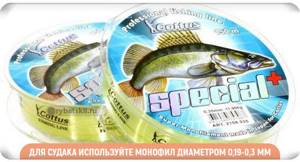
In most cases, for hunting pike perch in winter on sprat, there is no need to use carbines and fasteners. The bait can be safely secured using a Rapal knot. It will hold the bait tightly and will not overload the vein with additional elements. The American clasp is perfect for those situations where it makes sense to frequently replace the bait. You should not use metal leashes when catching pike perch; they often act as a deterrent.
Fishing technique:
- Use an echo sounder to study a specific area of the reservoir.
- Develop a working square by drilling 10–15 holes. The distance between them should be 5–10 m.
- Lower the rig with bait to the bottom.
- Raise the bait to a height of 20–30 cm if fishing occurs in medium/strong currents, and 40–50 cm when hunting in reservoirs with calm water and moderate currents.
- Start the game by activating the bait. First, make smooth lifts with the fishing rod up to a height of 20–40 cm, and then stop. Its duration can vary from a couple of seconds to one minute. Here you should adhere to the rule: the more active the predator, the shorter the pauses. The fishing algorithm comes down to alternating rises and stops. You can experiment - play with bait in a certain horizon.
- As soon as a bite is noticed, make a sharp hook and begin the process of landing the prey on the ice.

If the predator shows little interest in the sprat, then it is necessary to drill several holes and “load” 2-3 tackles. It happens that pike perch bites on a stationary bait. You can fish in several ways at the same time, one of them will definitely fail.
If hunting is carried out in areas with a current, then you need to give the bait the opportunity to swim further along it, so you will be able to catch a larger area. Considering that pike perch stays in groups in winter, when the hole is triggered, you should not hesitate to replace the bait. Close to one meter from this hole, you should drill another one; there will probably also be bites in it.
Zherlitsa for pike perch
Using girders for pike perch with sprat is especially effective if the target is an individual weighing 10 kg or more. You can make such a promising tackle with your own hands, if you know the technology and the principle of its design. For winter hunting, it is advisable to take a girder with a flag, which will inform you about a bite that has occurred under water. It is better to assemble the structure on a tripod, where a coil with a flexible metal plate and a red flag is mounted.
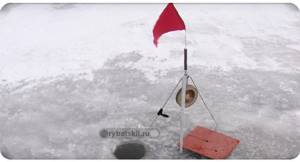
The tackle is equipped according to the following scheme:
- monofilament thickness 0.25-0.5 mm;
- leash with a diameter of 0.2-0.3 mm;
- the length of the monofilament on a reel is 10–20 m;
- single hook No. 9–12, double hook No. 6–7.
The main points of catching pike perch on girders in winter:
- Choose a location and drill at least 10 holes. It is worth installing the tackle 20 cm from the bottom, otherwise the sprat will get tangled on underwater objects. The distance between holes should be 10–15 m. It is best to drill working points along a small arc, a curved line. It is optimal to catch pike perch at different levels in order to be sure to find out where it is concentrated.
- If there are no bites within two hours, then the bait should be replaced. In case of prolonged downtime, it is recommended to move the gear to another location.
- After the bite, it is not advisable to rush into hooking. You need to pause for 20–30 seconds, during which time the predator will be able to completely swallow the bait. If you do this right away, the bait will simply fly out of his mouth, and he will fall apart when fishing.
Supply for pike perch in winter on sprat

This is a type of zherlitsa, its passive modification. This basic tackle is used not only for pike perch, but also for pike and other seasoned predators. The supply equipment for winter fishing includes:
- reel;
- monofilament with a diameter of 0.3-0.5 mm;
- sliding weight weighing 4–12 g;
- sinker limiter;
- leash;
- sharp hook.
Fishing with postavushi involves:
- Selecting a working area and drilling holes.
- Placing a sprat on a hook.
- Lowering the reel so that the load reaches the bottom surface.
- Pulling the line, raising the bait to a height of 20–30 cm.
- Fixing the coil with a flag.
- Observation of gear.
- Carrying out the hook 30 seconds after the bite.
- Fishing and bringing the gear into combat readiness.
Jigs for sprat
To ensure that winter fishing for sprat with a jig is always a success, it is worth using knockers and cones equipped with a single or double hook. Those options that work best are those in which the hook bend is directed upward at an obtuse angle. Thanks to this, the bait will be effectively located above the bottom. As for color, it's worth experimenting. Often pike perch reacts to green and black products. When hunting at night, it is important to use baits with fluorescent colors.

You can catch pike perch in winter using a sprat using a fishing rod, a girder, or a set-up, and the results will be the same when using jig heads. The main thing is to correctly determine the working area, arrange the gear correctly and not rush into hooking. Only with an integrated approach will it be possible to cope with such a worthy opponent.
Tactics for catching pike perch in winter
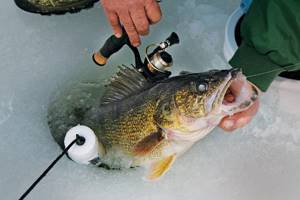
To decide on tactics for catching pike perch in winter, you need to know its route. As a rule, experienced fishermen, especially on a familiar body of water, have time to study its route of movement. At the same time, some fishermen begin to actively search for its parking place, while others drill holes directly on its route of movement and wait for the pike perch to approach its favorite place. Naturally, the larger catch goes to active fishermen, and those who are constantly waiting have only to admire nature. Although, it can also be the other way around, since it is difficult to understand the behavior of fish on any given day. As a rule, fish are unpredictable and pike perch is no exception: it can simply hide somewhere in the depths and not respond to any bait. Therefore, the method of catching pike perch depends on the fisherman himself: whichever one he chooses, that’s how he will practice it.
